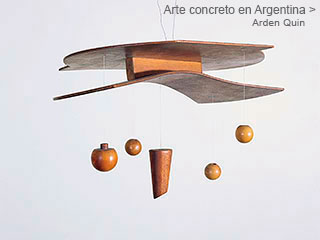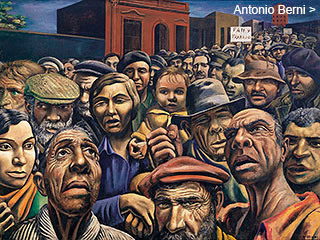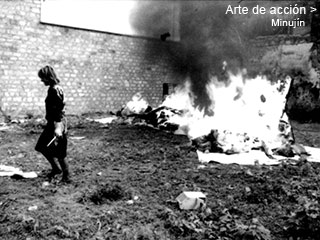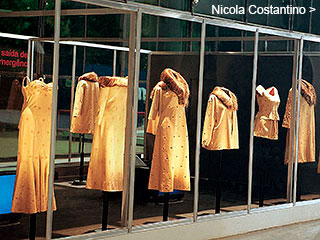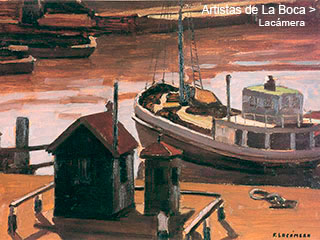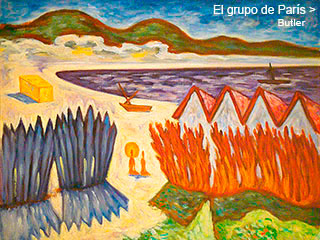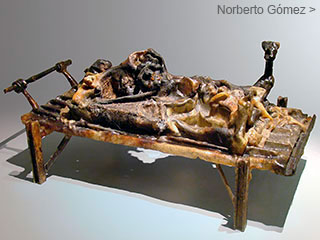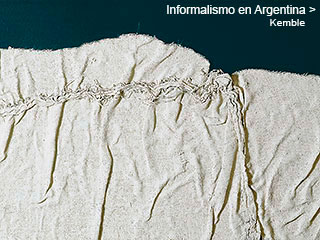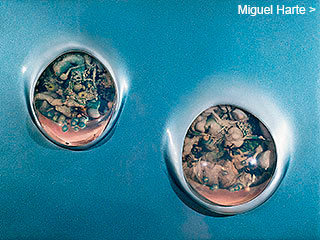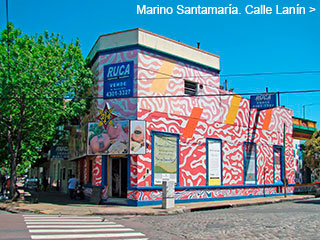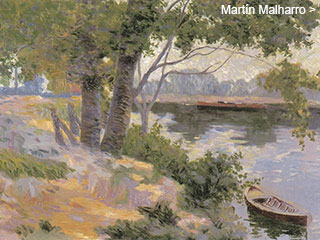Menú
Algunos dossiers
Concrete Art
in Argentina
in Argentina
by
Adriana Lauria
January 2003
January 2003
Abstraction asserted itself in Argentina through the achievements of groups such as Arte Concreto-Invención, Madí and Perceptismo, which developed their activity since the second half of the 1940s. These groups constituted the first organized national avant-garde and made their aesthetics known to the public through exhibitions, magazines, manifestoes, leaflets, lectures, etc.
Documents
C. Arden Quin
Carmelo Arden Quin. “Son las condiciones materials…” (It is the material conditions...), in Arturo magazine, Buenos Aires, 1944, no page number.
It is the material conditions of society what conditions the ideological superstructures.
Art, an ideological superstructure, is born and develops according to the economical movements of society.
That is the disclosure made by dialectic materialism about art.
For the exact interpretation of art, in its historical role, the following dialectic order has to be established. Primitivism Realism Symbolism.
Such is the order in which art has appeared throughout history.
Up to now, the essential features of these orders have been expression, representation and signification.
In Primitivism, man, deprived of reason and space in front of the external forces (beings, elements; both of them equally “things” for him) that pressed him, could not but represent his fears, uncertainties, and searches, transformed in superstitions, and magic, and signs in his works; which became expression for nature.
However, we would fall into an idealistic interpretation if we made of this the unique and permanent law of Primitivism, not conceding to it, at the same time, any dialectical development of its own; as well as with a representation and a symbolization [sic], thus reaching the understanding of the periods of realism (always within the rule of frontality) and geometrization in Primitivism, its monochrome and polychrome stages, and its stylization and return phases, here always as a retro gradation, as for instance the fourth epoch, in the Bushmen, which is a full return to red monochrome. What defines and characterizes Primitivism is the expression of things, composed under the law of frontality.
Primitivism (of a capital significance) lasted in all the strength of its magical expression, until the V century in Greece, where, for the first time in history, man replaced expression with pure optical representation.
After Greece, resumptions, such as those of Byzantium and Italy (determined by times of deep economic and social transformations. Passage from slavery to feudalism. Religious fears. Religious struggles.) have not been able to shake completely off the Hellenistic inheritance of representation. This inheritance would increase more and more, finally leading to Renaissance, of a pure and nearly photomechanical realism.
Nobody has considered through a materialistic dialectical thinking the School of Paris, realizing it has been the emotional and ideological outcome of a full transformation of the world.
Nobody has thought about subordinating the phenomenon of modern art, and its abstractions, to the process of economic and social annihilation of the capitalist regime, and to the creation of a new society under socialist ways of production.
We are living, in economy as well as in art, and the rest of the ideologies, a period of thesis; a period of resumption; a primitive period; but under scientific standards and structures, as opposite to the material, instinctive primitivism of the beginnings of history.
Art, dialectically, and with an amazing accuracy in terms of historical correspondence, has entered a full recommencement, and its creators, from the beginning and with great intuition, have seen in the art of the aboriginal peoples, its purest correspondence.
Human society, after its primitive communism, went through three economic regimes (slavery, feudalism, bourgeoisie) to return to its forgotten historic trenches. Yet returning only as a correspondence, for the very ascending march of history (Lenin stressed the Engelian proposition of a “coiling march”), keeps away that return from being an exact copy, which would mean a regression. History repeats itself, scientifically structured upon new conditions. The stages that meet again with each other through the constant development of history are thus separated by ascension gaps. In fact, history does not repeat itself, but it corresponds with itself.
So, expression, which in art has been the foundation for natural primitivism, came to be replaced with INVENTION, in modern, scientific primitivism. Their artists, more than pure intuitive artists, have been inventors. And more than a sense of imagination (Apollinaire was not very imaginative), they have had a sense of creation. That is why they have been able to rise, entirely aware (as movements prove it), the solid building of contemporary art.
Beyond the expression of nature (representations of himself), man engraved (imitating his footsteps on sand), and painted, on trees and on his caverns’ walls (previous to words; previous to thoughts; when he operated through nothing but his limbs; and instinctively) his bloody hands, or wet with vegetal sap; beyond the hunting time; in the middle of roots and fruits harvest time; first by chance; fortuitously; and then through imitation; and afterwards through inventive play; as it is possible to see even now among certain primitive peoples; i.e., the Eskimos and their ivory carvings in which no magical expression signs appear.
So, approaching deeper historical sources, we can find even purer correspondences for contemporary art. And this out of determinism. And not out of justification, something that history fails to recognize.
It is clear then that the expression can no longer be what rules the spirit of current artistic composition; no to mention a representation, be it a magic one, or a sign. The place has been taken by INVENTION, by sheer creation.
At this moment, Expressionism, Oneiric Automatism, etc., imply nothing but reaction and retrogression. And must be banished, abolished.
Automatism never produced a living creature. It only gave fetuses. Automatism is welcome to wake up imagination. And immediately recover and act upon it with a high artistic awareness, and calculations, even cold ones, patiently elaborated and applied. Automatically this will become creation.
So invention grows to be rigorous, not in the aesthetic means, but in the aesthetic goals. This, naturally, implies first the imagination outcropping in all its contradictions; and then the consciousness organizing imagination and depurating it from any naturalist, representative image (even if it is about dreams), and from any symbol (even if subconscious).
Neither expression (primitivism); nor representation (realism); nor symbolism (decline). INVENTION. Of anything; of any action; form; myth; just for the sake of playing; just for a sheer sense of creation: eternity. FUNCTION.


